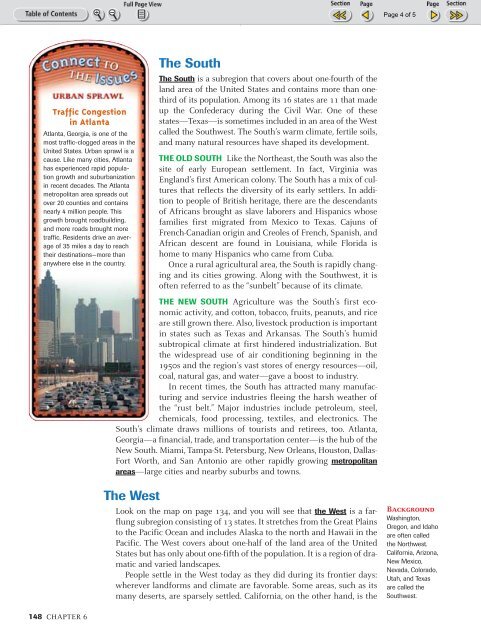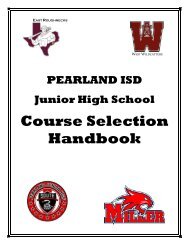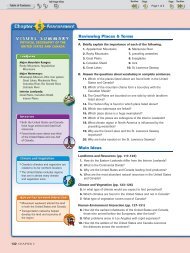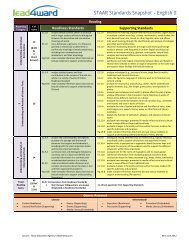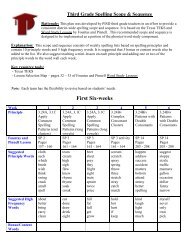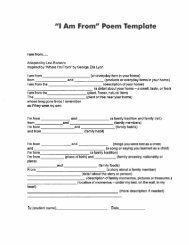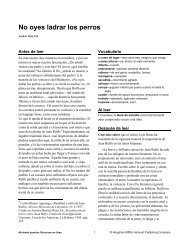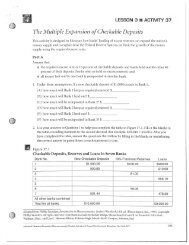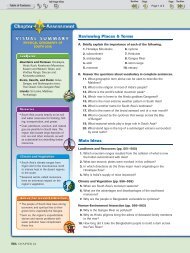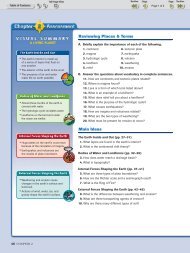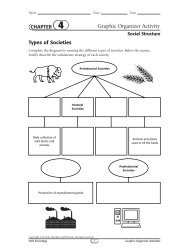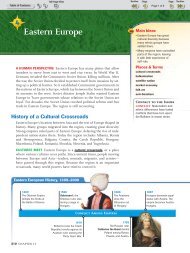Subregions of the United States
Subregions of the United States
Subregions of the United States
Create successful ePaper yourself
Turn your PDF publications into a flip-book with our unique Google optimized e-Paper software.
145-149-Chapter6 10/16/02 10:18 AM Page 148<br />
Traffic Congestion<br />
in Atlanta<br />
Atlanta, Georgia, is one <strong>of</strong> <strong>the</strong><br />
most traffic-clogged areas in <strong>the</strong><br />
<strong>United</strong> <strong>States</strong>. Urban sprawl is a<br />
cause. Like many cities, Atlanta<br />
has experienced rapid population<br />
growth and suburbanization<br />
in recent decades. The Atlanta<br />
metropolitan area spreads out<br />
over 20 counties and contains<br />
nearly 4 million people. This<br />
growth brought roadbuilding,<br />
and more roads brought more<br />
traffic. Residents drive an average<br />
<strong>of</strong> 35 miles a day to reach<br />
<strong>the</strong>ir destinations—more than<br />
anywhere else in <strong>the</strong> country.<br />
The South<br />
The South is a subregion that covers about one-fourth <strong>of</strong> <strong>the</strong><br />
land area <strong>of</strong> <strong>the</strong> <strong>United</strong> <strong>States</strong> and contains more than onethird<br />
<strong>of</strong> its population. Among its 16 states are 11 that made<br />
up <strong>the</strong> Confederacy during <strong>the</strong> Civil War. One <strong>of</strong> <strong>the</strong>se<br />
states—Texas—is sometimes included in an area <strong>of</strong> <strong>the</strong> West<br />
called <strong>the</strong> Southwest. The South’s warm climate, fertile soils,<br />
and many natural resources have shaped its development.<br />
THE OLD SOUTH Like <strong>the</strong> Nor<strong>the</strong>ast, <strong>the</strong> South was also <strong>the</strong><br />
site <strong>of</strong> early European settlement. In fact, Virginia was<br />
England’s first American colony. The South has a mix <strong>of</strong> cultures<br />
that reflects <strong>the</strong> diversity <strong>of</strong> its early settlers. In addition<br />
to people <strong>of</strong> British heritage, <strong>the</strong>re are <strong>the</strong> descendants<br />
<strong>of</strong> Africans brought as slave laborers and Hispanics whose<br />
families first migrated from Mexico to Texas. Cajuns <strong>of</strong><br />
French-Canadian origin and Creoles <strong>of</strong> French, Spanish, and<br />
African descent are found in Louisiana, while Florida is<br />
home to many Hispanics who came from Cuba.<br />
Once a rural agricultural area, <strong>the</strong> South is rapidly changing<br />
and its cities growing. Along with <strong>the</strong> Southwest, it is<br />
<strong>of</strong>ten referred to as <strong>the</strong> “sunbelt” because <strong>of</strong> its climate.<br />
THE NEW SOUTH Agriculture was <strong>the</strong> South’s first economic<br />
activity, and cotton, tobacco, fruits, peanuts, and rice<br />
are still grown <strong>the</strong>re. Also, livestock production is important<br />
in states such as Texas and Arkansas. The South’s humid<br />
subtropical climate at first hindered industrialization. But<br />
<strong>the</strong> widespread use <strong>of</strong> air conditioning beginning in <strong>the</strong><br />
1950s and <strong>the</strong> region’s vast stores <strong>of</strong> energy resources—oil,<br />
coal, natural gas, and water—gave a boost to industry.<br />
In recent times, <strong>the</strong> South has attracted many manufacturing<br />
and service industries fleeing <strong>the</strong> harsh wea<strong>the</strong>r <strong>of</strong><br />
<strong>the</strong> “rust belt.” Major industries include petroleum, steel,<br />
chemicals, food processing, textiles, and electronics. The<br />
South’s climate draws millions <strong>of</strong> tourists and retirees, too. Atlanta,<br />
Georgia—a financial, trade, and transportation center—is <strong>the</strong> hub <strong>of</strong> <strong>the</strong><br />
New South. Miami, Tampa-St. Petersburg, New Orleans, Houston, Dallas-<br />
Fort Worth, and San Antonio are o<strong>the</strong>r rapidly growing metropolitan<br />
areas—large cities and nearby suburbs and towns.<br />
The West<br />
Look on <strong>the</strong> map on page 134, and you will see that <strong>the</strong> West is a farflung<br />
subregion consisting <strong>of</strong> 13 states. It stretches from <strong>the</strong> Great Plains<br />
to <strong>the</strong> Pacific Ocean and includes Alaska to <strong>the</strong> north and Hawaii in <strong>the</strong><br />
Pacific. The West covers about one-half <strong>of</strong> <strong>the</strong> land area <strong>of</strong> <strong>the</strong> <strong>United</strong><br />
<strong>States</strong> but has only about one-fifth <strong>of</strong> <strong>the</strong> population. It is a region <strong>of</strong> dramatic<br />
and varied landscapes.<br />
People settle in <strong>the</strong> West today as <strong>the</strong>y did during its frontier days:<br />
wherever landforms and climate are favorable. Some areas, such as its<br />
many deserts, are sparsely settled. California, on <strong>the</strong> o<strong>the</strong>r hand, is <strong>the</strong><br />
Background<br />
Washington,<br />
Oregon, and Idaho<br />
are <strong>of</strong>ten called<br />
<strong>the</strong> Northwest.<br />
California, Arizona,<br />
New Mexico,<br />
Nevada, Colorado,<br />
Utah, and Texas<br />
are called <strong>the</strong><br />
Southwest.<br />
148 CHAPTER 6


